The global cholesterol API market is projected to increase from USD 336.9 million in 2025 to approximately USD 508.4 million by 2035. This growth represents a CAGR of 4.2% during the forecast period. In 2024, moderate demand was recorded across pharmaceutical and biotechnology sectors, largely driven by lipid-based formulations and increasing uptake of advanced drug delivery systems. By early 2025, stronger adoption was observed in therapeutic areas including vaccines, gene therapy, and ophthalmology.
Cholesterol continues to serve as a critical excipient in drug development, particularly in the formulation of lipid nanoparticles and liposomes. These systems have gained renewed importance following the global expansion of RNA-based vaccines and biologic drugs. In particular, demand for high-purity cholesterol has intensified due to its functional role in stability, absorption, and targeted delivery. As a result, several manufacturers have expanded their GMP-certified production facilities to meet both volume and quality expectations.
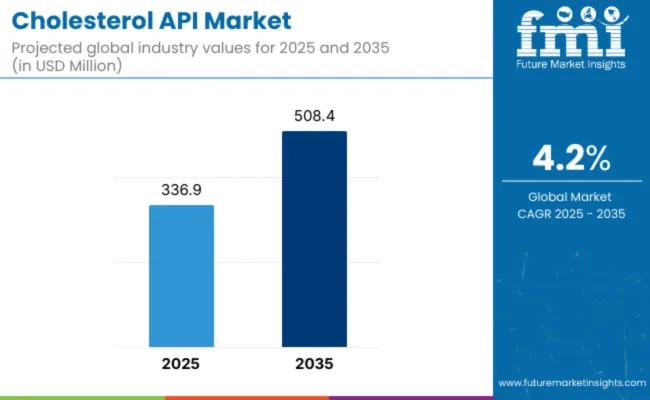
In 2025, increased attention is also being placed on ethical sourcing and contamination-free cholesterol. This has resulted in higher interest toward plant-derived and synthetic cholesterol alternatives. Companies such as Croda International, Dishman Carbogen Amcis, and Nippon Fine Chemical have introduced specialized cholesterol offerings tailored to niche segments, including vegan pharmaceuticals and precision medicine.
A recent industry trend involves integrating cholesterol into gene editing vectors and mRNA payloads. With growing investments in personalized medicine, the molecule’s structural compatibility and biocompatibility are seen as enablers of formulation innovation. Global supply chains have gradually shifted to balance between affordability and compliance, with Asia emerging as a hub for both GMP and non-GMP production.
With increasing therapeutic complexity and stricter regulations, the cholesterol API market is expected to remain on a stable upward trajectory through 2035.
Recent advancements have transformed how researchers retrieve and annotate cholesterol and related lipid species.
Beyond annotation, new tools automate workflows and enable real-time cholesterol tracking.
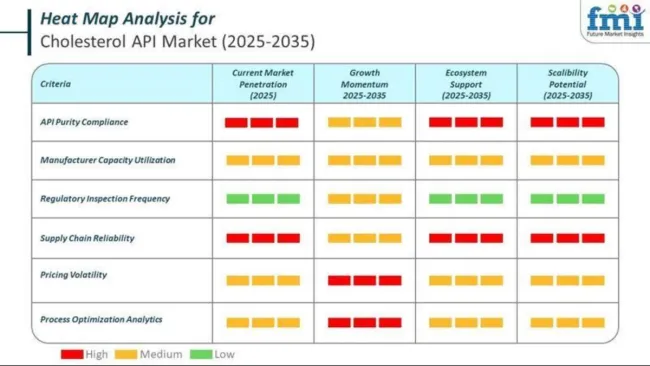
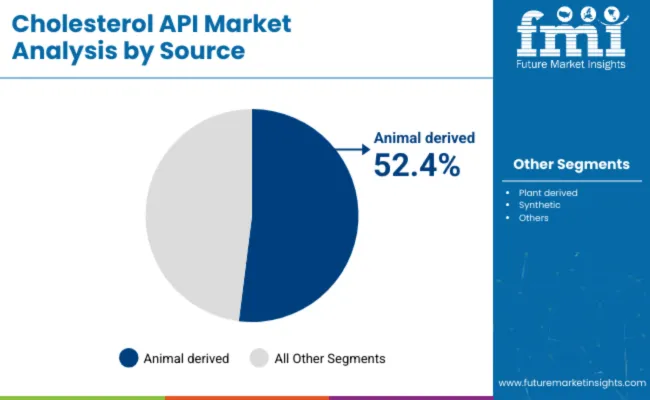
By Source, the cholesterol API market is led by animal-derived inputs, which are projected to hold 52.4% of the market in 2025. Extracted primarily from lanolin, this form is widely used in pharmaceutical applications due to its proven bioavailability and lower processing costs. However, ethical sourcing concerns and zoonotic risk are pushing producers to explore plant-derived alternatives.
Plant-based cholesterol, expected to capture 28.3% of the market, has found increasing relevance in clean-label drug formulations and is rapidly gaining ground in cell therapy, dermatology, and nutraceuticals. It is considered more sustainable and free from animal-origin contaminants. Meanwhile, synthetic cholesterol is forecast to account for 19.3% of the market by 2025.
Known for its high purity and lab-controlled consistency, it is increasingly favored in RNA therapeutics and gene delivery systems. Though costlier to produce, synthetic cholesterol offers precision vital for cutting-edge biologics. Overall, sourcing strategies are balancing between cost, ethical mandates, and application precision-driving a dynamic mix of traditional and innovative raw material preferences across cholesterol API production.
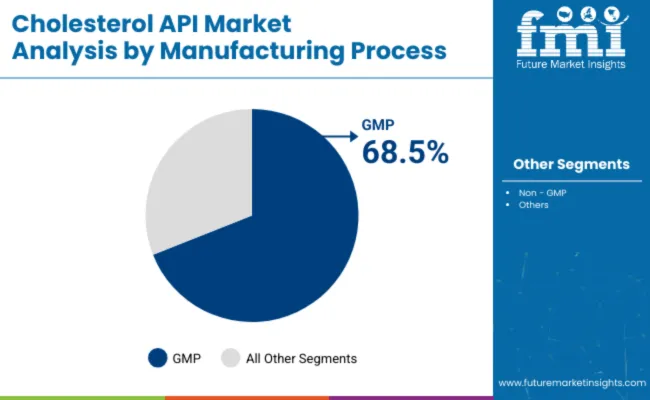
By Manufacturing Process, GMP-compliant cholesterol APIs are expected to dominate with a 68.5% market share in 2025. These are essential for pharmaceutical and biotech applications where regulatory adherence, batch reproducibility, and sterility are non-negotiable. GMP processing ensures traceability, robust documentation, and quality assurance across APIs used in injectable drugs, mRNA vaccines, and monoclonal antibody production.
Facilities aligned with FDA and EMA expectations have seen increasing orders, especially from firms scaling advanced biologics. In contrast, non-GMP cholesterol, projected to hold 31.5% of the market, continues to serve lower-risk segments such as cosmetics, food supplements, and academic research. These applications often prioritize affordability and speed, benefitting from shorter compliance timelines and flexible sourcing.
While the non-GMP segment lacks pharmaceutical-grade certification, its role in secondary markets remains vital. However, increasing global awareness about safety and product traceability is nudging even non-GMP producers toward partial standardization. The balance between GMP and non-GMP production is shaped by end-use compliance requirements, cost pressures, and the ongoing evolution of formulation science.
The North American region accounted for a significant share of the cholesterol API market, owing to the strong presence of biopharmaceutical companies, rising demand for lipid-based drug formulations, and increasing focus of various companies in the country on developing mRNA vaccines.
North America is spearheading the production of lipid excipients required to produce gene therapies, oncology drugs, and RNA-based therapeutics. Furthermore, regulatory approvals for the use of cholesterol-based excipients in vaccine formulations are expected to drive the growth of this market.
Europe accounts for a large share of the overall market, with Germany, France, and the UK venturing ahead in pharmaceutical research, biopharmaceutical production, and vaccines. In addition, the European Medicines Agency (EMA) focus on innovative drug delivery systems has led to an accelerated take up of cholesterol APIs in lipid-based formulations Furthermore, rising demand for high-purity cholesterol in dermatological and ophthalmic products in Latin America further bolsters the growth of the market.
The cholesterol API market in the Asia-Pacific region is expected to grow quickly on account of growing pharmaceutical manufacturing capabilities, drying contract development and manufacturing organization (CDMO) activities, and growing demand for lipid-based therapeutics. Strong investments in biotech innovations and vaccine production are seen in countries like China India and South Korea. Enjoying support from favorable government policies promoting local API manufacturing in the regions.
Challenge
High Production Costs and Regulatory Compliance
The Cholesterol API market restraints include the high costs related to purification, extraction, and synthesis. In addition, compliance burdens are increased with strict regulatory requirements regarding the quality, safety, and traceability of APIs. Moreover, raw material sourcing for animal-source cholesterol supply chain disruption may also disrupt the market and lead the price to fluctuate.
Opportunity
Rising Demand for Liposomal Drug Delivery and Plant-Derived Alternatives
The increasing pharmaceutical and biotechnology industries are driven the high demand for high purity cholesterol APIs, especially in liposomal drug formulations utilized in mRNA vaccines, targeted gifting and lipid-based delivery systems. Also, the new synthetic and plant-based cholesterol alternatives are helping to decrease dependence on animal-derived sources, providing a solution to sustainability concerns and expanding their regulatory approvals.
The cholesterol API market witnessed a significant push during the period 2020 to 2024 on account of its pivotal role in LNPs (lipid nanoparticles) utilized in mRNA vaccines, notably during the COVID-19 pandemic.
By 2025 to 2035 the market will be shifting to plant based and synthetic cholesterol substitutes to enhance product stability, quality and regulatory compliance. The market growth is also attributed to the technological advancements in bioprocessing and its use in fermentation-based cholesterol synthesis. Furthermore, the growing applications of nanomedicine, gene therapy, and lipid-based drug formulations will lead to opportunities for high-purity cholesterol APIs.
Market Shifts: A Comparative Analysis 2020 to 2024 vs. 2025 to 2035
| Market Shift | 2020 to 2024 Trends |
|---|---|
| Regulatory Landscape | Compliance with GMP and pharmacopoeia standards (USP, EP, JP) |
| Technology Innovations | Traditional animal-derived cholesterol extraction |
| Market Adoption | Growth in mRNA vaccines, liposomal drug delivery, and nutraceutical applications |
| Supply Chain & Sourcing | High dependence on animal-derived cholesterol |
| Market Competition | Dominated by established API manufacturers and pharma giants |
| Sustainability Trends | Initial efforts in reducing dependency on animal sources |
| Consumer Trends | Demand from vaccine production and lipid-based drugs |
| Market Shift | 2025 to 2035 Projections |
|---|---|
| Regulatory Landscape | Stricter oversight on API purity, traceability, and sustainability in raw material sourcing |
| Technology Innovations | Plant-based and synthetic cholesterol production for increased scalability and purity |
| Market Adoption | Expansion in gene therapy, personalized medicine, and advanced nanocarrier formulations |
| Supply Chain & Sourcing | Shift towards fermentation-based and biosynthetic cholesterol for consistent supply |
| Market Competition | Rise of biotech firms specializing in synthetic cholesterol and lipid-based formulations |
| Sustainability Trends | Large-scale adoption of plant-based and enzymatically synthesized cholesterol for greener production |
| Consumer Trends | Growth in cholesterol API applications in regenerative medicine and targeted drug delivery |
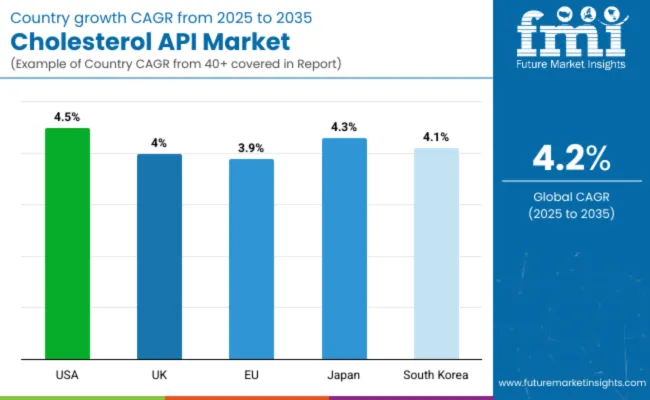
The United States Cholesterol API Market is projected to grow at a CAGR of around ~3% during the forecast period owing to prevalence of cardiovascular diseases and demand for lipid-based drug formulations. The robust pharmaceutical industry of the country, complemented by significant R&D expenditure in drug development, is driving the growth of cholesterol APIs for their utilization in a plethora of potent therapeutic applications, such as lipid nanoparticles for drug delivery.
Another key driver is the increasing usage of cholesterol-based APIs in vaccine formulations, including mRNA-based vaccines. Moreover, growing approval of cholesterol-based APIs by FDA for novel formulation of drugs is expected to drive the market growth, along with increasing trend of personalized medicine.
| Country | CAGR (2025 to 2035) |
|---|---|
| USA | 4.5% |
The UK Cholesterol API market is based on growing investments in pharmaceutical research, biotechnology, and a wide range of bioactive compounds. Statements issued by its officials indicate that there is a strong emphasis on developing innovative drug delivery systems (such as lipid-based formulations) across the country, which will in turn result in high demand for APIs with high purity cholesterol.
Several factors such as the evolving biopharmaceutical industry in the UK, particularly vaccine and gene therapy, also play an important role in the continued growth of the market. The increasing incidence of metabolic disorders, along with cardiovascular diseases, is further driving the appetite for cholesterol-based APIs in lipid-regulating medicines.
| Country | CAGR (2025 to 2035) |
|---|---|
| UK | 4.0% |
The European Union (EU) Cholesterol API market is expected to grow moderately due to the countries in the region having growing pharmaceutical and biopharmaceutical industry. Strict regulatory measures put forth by the European Medicines Agency (EMA) for high-purity APIS are prompting investment in advanced cholesterol API production.
These three countries alone account for a significant portion of the API produced, with many of their pharmaceutical and biotech firms involved in the production of cholesterol-based drug formulations. The rising application of the cholesterol APIs across lipid-based nanoparticle drug delivery systems such as mRNA vaccine technology is a key factor driving the market growth.
| Country | CAGR (2025 to 2035) |
|---|---|
| EU | 3.9% |
The Japan Cholesterol APIs market is increasing on account of the well-established pharmaceutical industry in Japan and the advancement of lipid-based formulations. Key Market Drivers Cholesterol-Based Pharmaceuticals in Demand due to Rising Elderly Population in Japan According to the World Population Ageing 2023 report, there are around 3.6 million people aged 65 and over suffering from cardiovascular diseases in Japan.
Further, the country's dominance in biopharmaceutical innovation, especially with respect to nanotechnology-enabled drug formulations, is creating a conducive environment for the growth of cholesterol APIs. Moreover, government-backed initiatives promoting research in precision medicine and vaccine development are driving the market growth.
| Country | CAGR (2025 to 2035) |
|---|---|
| Japan | 4.3% |
The South Korean Cholesterol API market is gradually growing owing to the growing pharmaceutical and biotechnology industries. This has increased the country demand for use of cholesterol API in lipid based drug formulation, candidate for targeted therapies and vaccine delivery.
Increase in chronic ailments like cardiovascular diseases and neurodegenerative disorders are further driving the adoption of cholesterol APIs in drug formulations. The country is also contributing to the growth of the market through its advances in nanomedicine and lipid-based drug delivery technologies.
Increasingly, government backing for pharmaceutical R&D, domestic and global API manufacturers' partnerships is further improving the country's stand in the cholesterol API market.
| Country | CAGR (2025 to 2035) |
|---|---|
| South Korea | 4.1% |
The market for Cholesterol Active Pharmaceutical Ingredient is growing steadily, and is highly beneficial to pharmaceuticals, biotechnology, cosmetics, and dietary supplements. Due to their utilization in liposomal drugs (liposomal formulation, development of mRNA vaccines, and lipid-based drug delivery etc.), Cholesterol APIs are critical in pharmaceutical development
Market Share Analysis by Key Players
| Company/Organization Name | Estimated Market Share (%) |
|---|---|
| Dishman Carbogen Amcis Ltd. | 20-24% |
| Croda International Plc | 16-20% |
| Nippon Fine Chemical Co., Ltd. | 12-16% |
| Sigma-Aldrich (Merck KGaA) | 10-14% |
| Tokyo Chemical Industry Co., Ltd. (TCI) | 8-12% |
| Others | 22-28% |
| Company/Organization Name | Key Offerings/Activities |
|---|---|
| Dishman Carbogen Amcis Ltd. | Specializes in high-purity cholesterol API for liposomal drug formulations and vaccine delivery. |
| Croda International Plc | Manufactures lipid-based cholesterol APIs for mRNA vaccines, pharmaceuticals, and cosmetic formulations. |
| Nippon Fine Chemical Co., Ltd. | Produces high-purity cholesterol for lipid nanoparticles (LNPs) and ophthalmic drug formulations. |
| Sigma-Aldrich (Merck KGaA) | Supplies research-grade and pharmaceutical-grade cholesterol for R&D and commercial applications. |
| Tokyo Chemical Industry Co., Ltd. (TCI) | Develops synthetic and natural cholesterol APIs for pharmaceutical and nutraceutical applications. |
Key Market Insights
Dishman Carbogen Amcis Ltd. (20-24%)
Dishman Carbogen Amcis leads the cholesterol API market with high-purity cholesterol solutions for liposomal drug delivery, vaccines, and gene therapy. The company has a strong presence in the pharmaceutical and biotech industries, supplying customized API solutions.
Croda International Plc (16-20%)
Croda is a key supplier of lipid-based cholesterol APIs, particularly for mRNA vaccines (e.g., COVID-19 vaccines) and gene therapy applications. The company has advanced manufacturing capabilities to support the global demand for lipid nanoparticles (LNPs).
Nippon Fine Chemical Co., Ltd. (12-16%)
Nippon Fine Chemical focuses on pharmaceutical-grade cholesterol production, catering to ophthalmic drug formulations, lipid-based drug delivery systems, and nutraceuticals.
Sigma-Aldrich (Merck KGaA) (10-14%)
Sigma-Aldrich, a subsidiary of Merck KGaA, provides high-purity cholesterol APIs for research, biotechnology, and pharmaceutical applications. The company plays a crucial role in R&D for drug formulation and lipid-based delivery systems.
Tokyo Chemical Industry Co., Ltd. (TCI) (8-12%)
TCI offers synthetic and natural cholesterol APIs, widely used in pharmaceutical formulations, cosmetics, and dietary supplements. The company has an expanding presence in Asia-Pacific and North American markets.
Other Key Players (22-28% Combined)
| Report Attributes | Details |
|---|---|
| Current Total Market Size (2025) | USD 336.9 million |
| Projected Market Size (2035) | USD 508.4 million |
| CAGR (2025 to 2035) | 4.2% |
| Base Year for Estimation | 2024 |
| Historical Period | 2020 to 2024 |
| Projections Period | 2025 to 2035 |
| Quantitative Units | USD million for value |
| Product Types Analyzed (Segment 1) | Animal Derived, Plant Derived, Synthetic |
| Applications Analyzed (Segment 2) | RNA Vaccines, Monoclonal Antibodies, Others |
| Sample Types Analyzed (Segment 3) | Not Applicable |
| Distribution Channels Analyzed (Segment 4) | Not Applicable |
| Regions Covered | North America; Latin America; Western Europe; Eastern Europe; South Asia and Pacific; East Asia; Middle East & Africa |
| Countries Covered | United States, Canada, Germany, United Kingdom, France, Japan, China, India, South Korea, Brazil |
| Key Players Influencing the Market | Dishman Carbogen Amcis Ltd., Croda International Plc, Nippon Fine Chemical Co. Ltd., Sigma-Aldrich (Merck KGaA), Tokyo Chemical Industry Co. Ltd. (TCI), Merck KGaA, Cayman Chemical (Matreya), CordenPharma, NOF Corporation, Evonik Industries AG, Akums Drugs & Pharmaceuticals Ltd. |
| Additional Attributes | Preference for GMP-grade APIs, Growing use in vaccine and biologics development, Regulatory compliance for pharma-grade cholesterol synthesis |
| Customization and Pricing | Customization and Pricing Available on Request |
The overall market size for cholesterol API market was USD 336.9 million in 2025.
The cholesterol API market is expected to reach USD 508.4 million in 2035.
The growth of the cholesterol API market will be driven by increasing demand in pharmaceutical formulations, advancements in lipid-based drug delivery systems, and rising adoption in cosmetic and dietary supplement industries for enhanced product efficacy.
The top 5 countries which drives the development of cholesterol API market are USA, European Union, Japan, South Korea and UK.
Animal-Derived Cholesterol APIs to command significant share over the assessment period.






Full Research Suite comprises of:
Market outlook & trends analysis
Interviews & case studies
Strategic recommendations
Vendor profiles & capabilities analysis
5-year forecasts
8 regions and 60+ country-level data splits
Market segment data splits
12 months of continuous data updates
DELIVERED AS:
PDF EXCEL ONLINE
Cholesterol Esterase Market Size and Share Forecast Outlook 2025 to 2035
Cholesterol Medicine Market Size and Share Forecast Outlook 2025 to 2035
Cholesterol and Lipid Test Market Size and Share Forecast Outlook 2025 to 2035
Cholesterol Monitors Market Size and Share Forecast Outlook 2025 to 2035
Cholesterol Control Supplements Market – Growth, Demand & Health Trends
Cholesterol Reduced Butter Market
HDL Cholesterol Kits Market Size and Share Forecast Outlook 2025 to 2035
Point-of-care Cholesterol Monitoring Device Market Size and Share Forecast Outlook 2025 to 2035
Low-Fat and Low-Cholesterol Diet Market Growth - Health Trends 2025 to 2035
Heterozygous Familial Hypercholesterolemia (HEFH) Management Market Trends - Innovations & Growth 2025 to 2035
Apigenin Market Size and Share Forecast Outlook 2025 to 2035
API Monetization Platform Market by Component, Enterprise Size, Industry & Region Forecast till 2035
Rapid Microbiology Testing Market Forecast Outlook 2025 to 2035
Rapid Test Cards Market Size and Share Forecast Outlook 2025 to 2035
Rapid Prototyping Materials Market Size and Share Forecast Outlook 2025 to 2035
Rapid Test Readers Market Size and Share Forecast Outlook 2025 to 2035
Papillary Thyroid Cancer Market Size and Share Forecast Outlook 2025 to 2035
Tapioca Pearls Market Analysis - Size, Share, and Forecast 2025 to 2035
Rapid Strength Concrete Market Size and Share Forecast Outlook 2025 to 2035
Rapid Self-Healing Gel Market Size and Share Forecast Outlook 2025 to 2035

Thank you!
You will receive an email from our Business Development Manager. Please be sure to check your SPAM/JUNK folder too.
Chat With
MaRIA